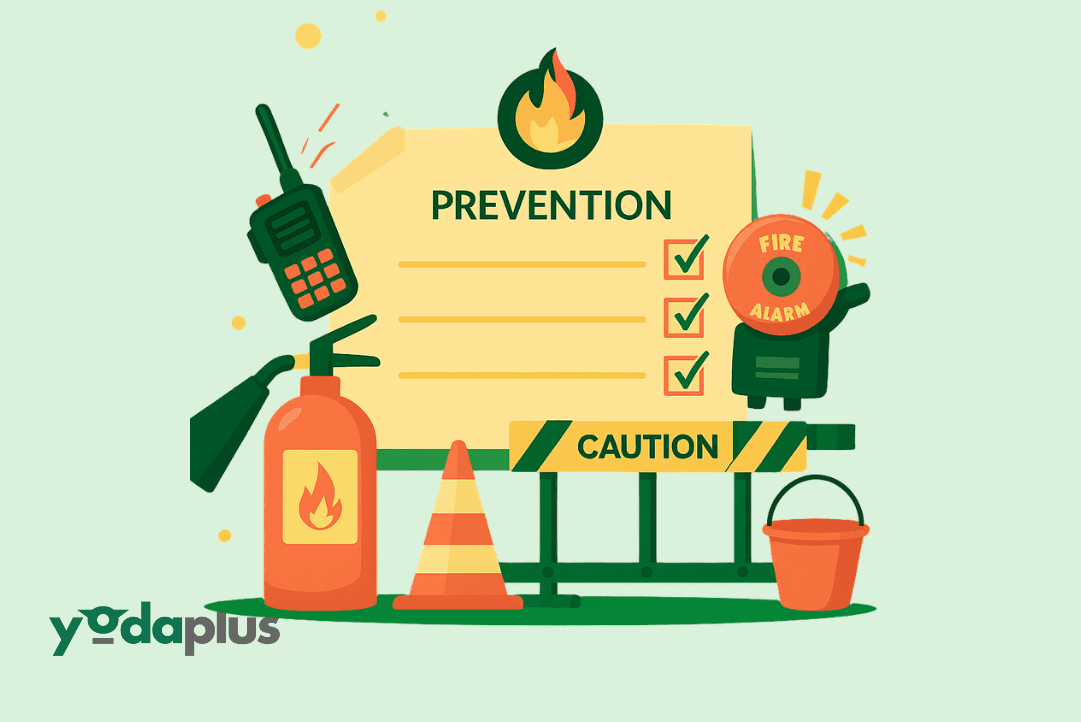
Fire Control Plan and Its Role in Shipping Documentation
August 5, 2025 By Yodaplus
Fire is one of the most dangerous emergencies onboard a ship. With limited escape routes and flammable materials around, even a small fire can become a major threat to lives, cargo, and the vessel itself. That’s why every ship must have a well-documented and clearly displayed Fire Control Plan.
This plan is not just another sheet in your folder of shipping documents. It is a lifesaving tool, a regulatory requirement, and a vital part of your ship’s maritime compliance system. Understanding what it is, how it works, and why it’s necessary is essential for every seafarer, safety officer, and inspection team.
What Does Fire Control Plan Mean?
The Fire Control Plan is a detailed diagram or set of diagrams that shows the layout of fire detection and firefighting equipment throughout the vessel. It includes information about:
- Locations of fire extinguishers, fire hoses, and hydrants
- Fixed fire suppression systems
- Emergency exits and escape routes
- Locations of fire alarm switches and emergency shut-offs
- Fire protection zones onboard
The plan must follow specific IMO regulations and SOLAS requirements. It is part of mandatory shipping documentation and must be placed in accessible areas such as the accommodation block and the bridge.
A copy of the Fire Control Plan is also often stored in a watertight container outside the deckhouse for use by emergency personnel during Port State Control inspections or rescue operations.
How Does It Help?
In the event of a fire, every second matters. A clear and updated Fire Control Plan helps in the following ways:
1. Faster Emergency Response
The plan allows crew members to quickly locate firefighting equipment and understand how to contain the fire. Without clear directions, delays can occur and that can be dangerous in a fire situation.
2. Effective Crew Training
As part of STCW standards, seafarers are trained in emergency drills. The Fire Control Plan is a core part of that training. Crews use it during fire drills to simulate responses and prepare for real incidents.
3. Inspection Readiness
Regulatory bodies such as Sire Vetting teams and Port State Control officers often check for an updated and accurate Fire Control Plan. Failure to maintain this plan can result in detentions, fines, and risk ratings that affect the vessel’s operational status.
4. Coordination with External Rescuers
During a fire emergency, external responders may come onboard. The Fire Control Plan helps them understand the ship layout quickly, aiding faster decision-making.
Why Is It Necessary?
Fire onboard is not just a safety issue. It is also a matter of international regulatory compliance. Several maritime codes and regulations mandate the presence of a Fire Control Plan, including:
- SOLAS: Requires all ships to carry and display fire control plans.
- ISM Code: Ensures shipowners manage safety, including fire risk.
- Maritime environmental compliance: Fires can lead to oil spills or chemical release. Preventing these incidents protects the marine ecosystem and aligns with MARPOL standards.
Having a Fire Control Plan is not optional. It is a part of your ship documents, expected under maritime regulations, and necessary for smooth shipping compliance.
Digitalizing the Fire Control Plan
Traditional paper-based maritime documentation can get damaged or misplaced, especially during emergencies. Today, more companies are turning to document intelligence platforms that digitize and auto-update important ship records, including the Fire Control Plan.
These platforms improve visibility, make updates easier, and allow inspection teams to access accurate data instantly.
Key Features of a Good Fire Control Plan
To be effective and compliant, a Fire Control Plan should:
- Be up to date with the latest ship modifications
- Be easy to read and color-coded as per IMO regulations
- Be available in the working language of the crew
- Be placed at required locations and accessible in digital form if possible
It should also align with the broader HSEQ policies of the company and support the ship’s ISPS Code and ISGOTT practices where applicable.
Conclusion
Fires onboard are serious. But with the right tools, they can be controlled before they become disasters. The Fire Control Plan is more than a regulatory checkbox. It is a critical part of your safety toolkit, your inspection checklist, and your everyday preparedness strategy.
For shipping companies and operators looking to streamline safety and compliance, investing in digital documentation can be a game changer. That’s where OceanDocs from Yodaplus comes in. It helps you organize, access, and update fire safety plans and other essential shipping documents with ease keeping you inspection-ready, audit-secure, and always prepared.